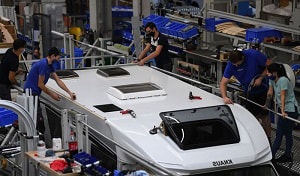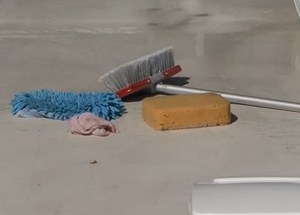When you’re on the route, RV roofing needs to withstand a variety of weather situations. As an outcome, they must be changed. If you’re not assured which material to select for your RV roof replacement, here’s a comparison of TPO vs Fiberglass RV roof to help you decide.
Besides discussing the differences between the two materials, we also show how to care for your RV roof so that it lasts a long time.
Page Contents
TPO Roof
TPO, or Thermoplastic Polyolefin, roofing is a relatively new trend in the RV market, but it has quickly gained popularity and replaced PVC roofing. Its appeal may be attributed to its low price and white hue.
TPO may be acquired in the form of a rubber membrane from any industry-experienced manufacturer. Because they are big sheets, you can purchase one that will exactly fit the top of your RV and attach it with industrial-grade adhesives or heavy-duty fasteners.
1. Benefits of TPO Roofs
- No puncture or leaking – TPO is a seamless and durable roof for your RV since it resists mold growth, does not collect dirt, and can withstand even the most severe impacts without punctures. Roof leaking occurs as a result of thermal expansion and contraction when you move through various climates. What’s more, guess what? Thor TPO roof may be strengthened to withstand these occurrences.
- UV-resistant – Furthermore, since the TPO can protect us from the sun’s rays, we may take our RV to a hotter location for vacation.
- Nice color that quickly cools down – Its beautiful white color also helps. TPO keeps your RV cooler since the white hue reflects heat and enables it to cool down more quicker. TPO is also available in nearly any color so that you may play around with the color of your roof.
- Cost-effective – TPO is also renowned for being energy-efficient since it keeps the warmth and cooling in the TV for more extended periods, saving you money on air conditioning and heating. TPO has lower installation costs since it is lightweight, and just one sheet is needed to cover the whole vehicle.
2. Downsides of TPO Roofs
While the benefits of TPO make it seem like the ideal roofing material, there are a few drawbacks.
- Not that durable – To begin with, TPO is a very new technology, having been introduced in the 1990s, and producers are currently striving to improve its durability. Manufacturers are experimenting with the material to discover a solution for its long-term endurance, which may be available shortly.
- Prone to deterioration upon long exposure to heat – Another problem with TPO is that it can’t handle a lot of heat. In layman’s words, if you park your RV in the blazing sun for an extended period, the TPO roof may suffer from severe weathering.
GRD (Glass Reinforced Polyester) Flat Roof
Another material that may keep your RV operating smoothly and without any leaks is fiberglass. Several layers of glass fiber reinforced on top of each other create a robust structure that is both more expensive and heavier than other rubber-based roof materials such as EPDM and TPO.
On the other hand, fiberglass easily outperforms rubber roofs in terms of durability, strength, and maintenance requirements.
It’s fair to say that you can put your fiberglass roof to rest soon after it’s installed since it doesn’t need regular maintenance and keeps your RV well-insulated, providing warmth in the winter and cool air in the summer.
Furthermore, fiberglass expands and contracts in response to the weather, enabling you to travel throughout the nation without worrying about wear and tear.
The Difference Between TPO vs. Fiberglass Roofing
1. Cost
While TPO is less costly, costing between $5 and $16 per square meter, fiberglass is more expensive, costing between $90-$115 per square meter.
If you’re on a limited budget, opt for TPO or increase your budget by nine times to include some high-quality fiberglass for your RV’s roof!
2. Maintenance
We’re taken aback by how expensive fiberglass is due to the lack of upkeep it needs over time. RV roof repair is uncommon with fiberglass roofing, so if you have it installed the first time correctly, you can forget about it for the following 30-50 years.
On the other hand, TPO may endure for up to 20 years if you are committed to it, parking your RV in low-heat areas and taking care of it.
3. Quality
Fiberglass outperforms TPO in terms of quality, with a string that can withstand virtually any weather situation. No amount of thermal stress will break the will of fiberglass to keep you safe in your RV, and correct installation will eliminate any concerns about leaks.
The quality of TPO, on the other hand, is determined by the production process. If you’re a frequent camper who enjoys visiting far-flung locations, TPO may not be the best choice for temperature resistance.
If we’re talking about similarities, both of these materials offer excellent insulation for your RV, making it comfortable even in the most extreme weather. In this case, the performance of fiberglass is still superior to that of TPO.
Advice on Roof Maintenance
Here are some roof care recommendations that we learned from RV professionals, as promised at the start.
1. Roof Coating for RVs
An RV roof coating is a protective layer that may be applied to your roof to make it water-resistant and weatherproof. Replace this coating every year since it may wear off quickly on an RV rubber roof and requires reapplication.
You may utilize Heng’s Rubber Roof Coating or Dicor Corporation’s Rubber Roof Coating.
2. Liquid Roof for RVs
You can always give your RV roofing an additional layer of protection with a liquid roof coating if you want to add a beautiful shine and protect it from the sun’s UV rays. It extends the rubber roof’s life and protects it from water damage.
3. Cleaning the Roof of the RV
Washing the RV roof regularly will prevent mold from growing, insects from breeding due to water buildup, and dirt and debris from puncturing it. The top of your RV may be washed with a light detergent. You may want to look into rubber-safe RV roof cleaners.
4. Roof Covers for RVs
A UV-resistant cover for your RV is an excellent option since it will keep it shielded from the sun and rain at all times. This will save you from paying for a second parking spot for the RV while it is not in use.
Conclusion
To summarize the comparison between TPO vs Fiberglass RV roof – a fiberglass roof may burn a hole in your wallet, but it will serve your RV well if you go camping nearly every season. Additionally, you will save cash by not having to purchase roofing maintenance equipment.
Those whose current budgets do not allow fiberglass roofing may invest in the aforementioned methods to preserve the RV roof. Meanwhile, rubber roofing can last longer with proper care, saving you money and providing usefulness.
“Hi, I’m Francis’ husband—Calvin. Our story began with our shared passion for traveling. I have had a career journey for over 11 years at Ford Motor Company, where I took on the role of BMS SW Process Engineer.
Together with my wife, I have dedicated countless hours to exploring every nook and corner of the world. Ten years living in an RV may seem long, but time seems to fly by when I’m doing what I love with the person I love.
FMCA’s 103rd International Convention & RV Expo in Gillette, WY,
Like my wife, I hope to help you see the beauty of traveling off the beaten path by sharing insights into this lifestyle. In addition to my corporate roles, I also launched our website – Outdoorbits, in 2015 and continue to contribute my knowledge and skills to the present day. And I’ll be completely honest with you—no hiding the truth or sugarcoating the possible challenges.
So, if you want to run away from the busy lifestyle to embrace nature, I’m your guy.”












